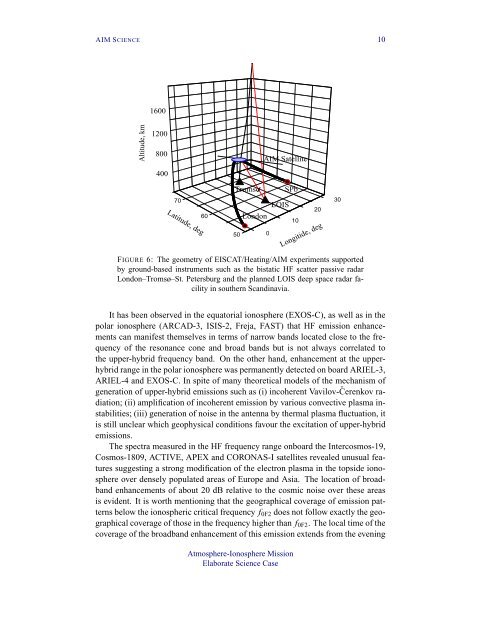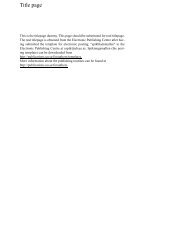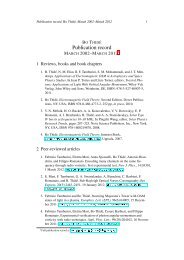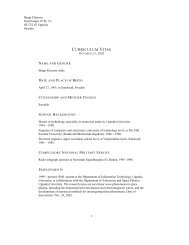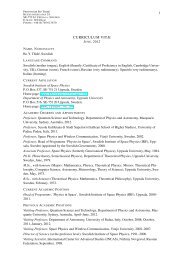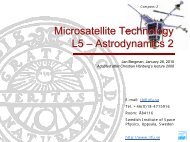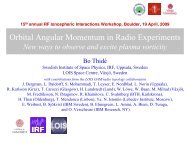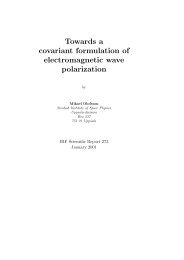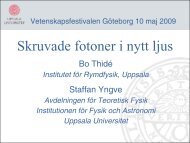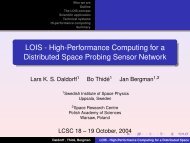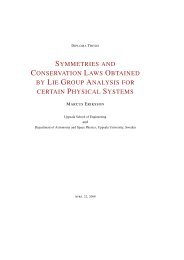Atmosphere-Ionosphere Mission - Swedish Institute of Space ...
Atmosphere-Ionosphere Mission - Swedish Institute of Space ...
Atmosphere-Ionosphere Mission - Swedish Institute of Space ...
You also want an ePaper? Increase the reach of your titles
YUMPU automatically turns print PDFs into web optimized ePapers that Google loves.
AIM SCIENCE 10<br />
FIGURE 6: The geometry <strong>of</strong> EISCAT/Heating/AIM experiments supported<br />
by ground-based instruments such as the bistatic HF scatter passive radar<br />
London–Tromsø–St. Petersburg and the planned LOIS deep space radar facility<br />
in southern Scandinavia.<br />
It has been observed in the equatorial ionosphere (EXOS-C), as well as in the<br />
polar ionosphere (ARCAD-3, ISIS-2, Freja, FAST) that HF emission enhancements<br />
can manifest themselves in terms <strong>of</strong> narrow bands located close to the frequency<br />
<strong>of</strong> the resonance cone and broad bands but is not always correlated to<br />
the upper-hybrid frequency band. On the other hand, enhancement at the upperhybrid<br />
range in the polar ionosphere was permanently detected on board ARIEL-3,<br />
ARIEL-4 and EXOS-C. In spite <strong>of</strong> many theoretical models <strong>of</strong> the mechanism <strong>of</strong><br />
generation <strong>of</strong> upper-hybrid emissions such as (i) incoherent Vavilov-Čerenkov radiation;<br />
(ii) amplification <strong>of</strong> incoherent emission by various convective plasma instabilities;<br />
(iii) generation <strong>of</strong> noise in the antenna by thermal plasma fluctuation, it<br />
is still unclear which geophysical conditions favour the excitation <strong>of</strong> upper-hybrid<br />
emissions.<br />
The spectra measured in the HF frequency range onboard the Intercosmos-19,<br />
Cosmos-1809, ACTIVE, APEX and CORONAS-I satellites revealed unusual features<br />
suggesting a strong modification <strong>of</strong> the electron plasma in the topside ionosphere<br />
over densely populated areas <strong>of</strong> Europe and Asia. The location <strong>of</strong> broadband<br />
enhancements <strong>of</strong> about 20 dB relative to the cosmic noise over these areas<br />
is evident. It is worth mentioning that the geographical coverage <strong>of</strong> emission patterns<br />
below the ionospheric critical frequency f 0F2 does not follow exactly the geographical<br />
coverage <strong>of</strong> those in the frequency higher than f 0F2 . The local time <strong>of</strong> the<br />
coverage <strong>of</strong> the broadband enhancement <strong>of</strong> this emission extends from the evening<br />
<strong>Atmosphere</strong>-<strong>Ionosphere</strong> <strong>Mission</strong><br />
Elaborate Science Case


